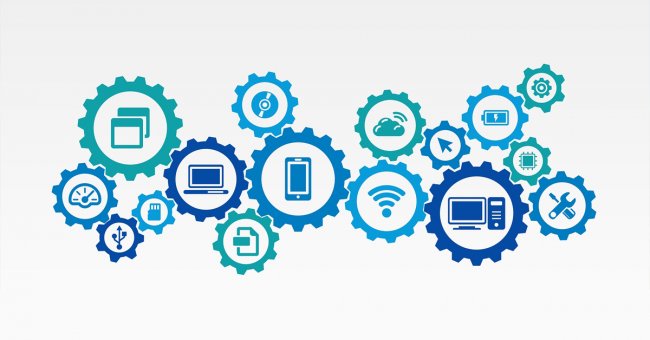ONE
Many organizations across the world would find themselves at the very first stage of digital and operational maturity, which is also referred to as the Digital Novice. A Digital Novice is an organization where the digital infrastructure exists in a very basic form. There might be IT applications deployed across the supply chain but the level of connectivity is minimal.
Products and services offered are marketed and focused on whereas the customer’s voice is considered secondary. Online applications are not capable of pulling offline data, which basically means that a more traditional set-up exists in terms of marketing products and servicing customers.
Automation and digitization is at very rudimentary levels and at best covers parts of the business process. The IT infrastructure of such organizations is highly fragmented, applications exist as islands and very rarely provide meaningful information which can be leveraged to create value at the highest level. Even the needs of digitization are not well understood, issues like compliance, risk management, tax, and Intellectual Property related issues are not being addressed.
Remodeling the operation in a phased manner would definitely help achieve I 4.0 level of maturity, but in order to understand how one needs to improve and move to the next level of maturity, it is critical to understand the different levels and assess current operation to chalk out key improvement areas. All this becomes a lot easier when an I 4.0 team works with IT leaders and experts to perform a maturity roadmap, but more on this later.
TWO
In the next stage of maturity, which is also referred to as the Vertical Integrator, organizations are typically well connected at the customer end, however lack the horizontal integration mandatory to be fully mature for adhering to I 4.0 requirements. It is typical for them to have highly digital solutions for customers where a number of products and services are offered to customers, and high M2M connectivity allows for such companies to be differentiated from competition.
In such companies digital and non-digital channels are well connected and data analytics drives personalization. They have a larger degree of customer focus as compared to a digital novice but lack the horizontal integration required to derive maximum value out of the digitization at the company level.
Such organizations portray a very homogeneous internal IT infrastructure, where vertical integration of IT applications allows better understanding of the internal process and the analysis of customer related information drives value addition. A vertical integrator organization, has the capability to recognize the challenges higher digital connectivity presents, but these challenges have not yet been fully addressed.
THREE
The next level of maturity is called the ‘Horizontal Collaborator’. The chances are that industries which fall under the highly automated segment and the ones which have already implemented practices like Lean and Six Sigma, along with other IT applications like the MES/MOM, ERP and CRM etc. are likely to feature at this advanced level of maturity.
Such organizations provide highly personalized and almost individualistic product and service offerings. They collaborate with external partners beyond their company’s digital boundaries and allow that collaboration to drive business improvement. The flow of data in such value chains is almost unrestricted - data originating from customer end is relayed to the external partners, who in turn use the data to analyze and derive information, which is then used by the organization to meet the customer expectations.
Legal risks associated with data transfer across the value chain are well addressed and risks associated are mitigated through conscious efforts. The company culture promotes sharing of information across organizational boundaries and employees place customer at the center of improvements driven by said collaboration.
FOUR
The fourth and highest level of maturity is that of a ‘Digital Champion’. These organizations are fully geared up to derive the maximum benefits the I 4.0 has to offer through extremely connected and dynamic processes, which can adjust quickly to market requirements and keep high focus of customer related data. Typically, a Digital Champion would float highly disruptive models of business, which are customer-centric and innovative in the sense that they provide personalization to the highest possible extent.
Integrated Customer Journey Management is a reality in such value chains, where customer empathy is given high degree of importance across the sales function and throughout the supply chain. Applications like the CRM play an important role in such organizations and information collected outside traditional realms is also well utilized and captured in a structured manner. These organizations have a sort of virtualized, self-optimized and de-centralized structure, where intense integration with partners allows for autonomy at various functional levels.The decision making is governed by being able to service the customer better.
The IT infrastructure for such organizations is fully connected through various applications, like the ERP, MES/MOM, SCM, CRM, sort of forming a partner service bus, allowing seamless integration with highest level of data security. The value chains are highly optimized in risk management, taxation and intellectual property related matters, where efforts are made genuinely to conserve value for all partners and focus is diverted towards effective problem solving.
The organizational culture pivots around collaboration among stakeholders and this collaboration and heightened connectivity are the major drivers of value creation. Having a culture which not only is pro-collaboration but also harbors the thought that the collaboration actually creates better value is a major challenge for organizations. This is where a lot of work needs to be done by almost every organization in the world, irrespective of their industry segment.
In our articles to come, we will explore how the industry leaders and top organizations of the world are gearing themselves up to deal with the challenges posed by the Industry 4.0 and how transitions can be made by entire value chains to move from being a Digital Novice to a Digital Champion.

